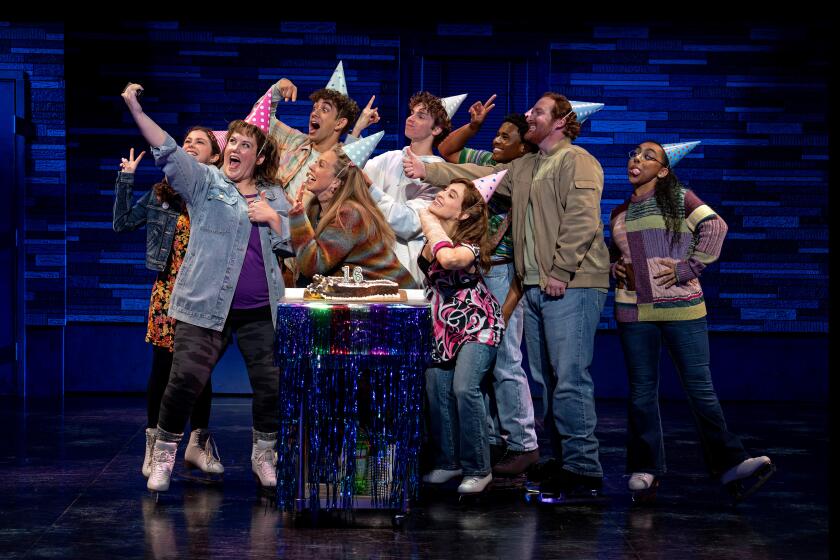Transformation : Retired Cabinetmaker’s Rendering of Father Serra Helps Resurrect a Statue Ravaged by Sea Air, Time
Toting his customary brown-bag lunch, Wilbur Rubottom unlocked the door of the empty shop at 10 a.m. and walked into a makeshift studio thick with the scent of wood chips.
After heating water for a cup of decaffeinated coffee, the 73-year-old retired cabinetmaker removed his carving tools and arranged them in surgical fashion, evenly spaced, with sharpened edges all pointing in the same direction.
Then, as he has done for six days of every week in the last nine months, Rubottom slid a plastic tarpaulin off a block of laminated lumber to reveal a likeness of Father Junipero Serra, the Spanish missionary known as “the Apostle of California.”
“We don’t have a ‘mother hen complex’ about it,” Rubottom said. “And we can’t engage in fantasies, like saying it’s taking on a life of its own--because it’s not. It’s just a piece of wood that we’re trying to give some form and beauty to.”
Since the beginning of the project in February, busloads of schoolchildren, senior citizens and tourists have poured in to watch Rubottom and his team work in the public studio, a converted livery on Palm Street in downtown Ventura that the city has leased for him.
With temperance and modesty, Rubottom has led a group of 16 carvers shaping an exact replica of a 51-year-old concrete statue of Serra that is slowly deteriorating in front of City Hall.
Victim of Sea Air
Built by John Palo-Kangas, a Finnish-born sculptor from Meiners Oaks, the statue’s sand and gravel aggregate has been affected by Ventura’s moist sea air. The monument has cracked on the outside and crumbled within.
After the wooden replica is finished, sometime near the end of the year, a mold will be made from it, and a bronze figure will be cast to replace the decaying statue.
The wooden version will probably be displayed in the new City Hall atrium, and the county Historical Society Museum or the San Buenaventura Mission will probably house the original statue. Serra founded the mission and eight others from San Diego to San Francisco.
As each cut into the figure, 9 feet by 4 feet, has become more delicate and critical, most of the woodworking team has had to step aside and let Rubottom’s muscular hands shape the half-ton slab of basswood.
Usually with the help of two other carvers, he meticulously defines the missionary’s hairline, forms the low-slung cowl, sharpens a cheekbone. He pauses only to answer questions from visitors.
“Some people come by and ask, ‘Have you always been a whittler?’ ” Rubottom said. “My response is that a whittler is someone who sits on the front porch making chips and spitting tobacco. I have never been a whittler.”
A husky and vigorous man, Rubottom acquired his woodworking skills as a high school student in Los Angeles, where he took a vocational course in cabinetmaking during the Depression.
“My parents couldn’t afford the tuition for college,” he said. “I wanted some subject that would prepare me to work.”
Carving Apprenticeship
The course eventually led to an apprenticeship with a master carver, who taught Rubottom the fundamentals of the craft. One of his early accomplishments was carving a heart-shaped box out of a block of Honduras mahogany for his wife, Anne, shortly before their marriage in 1936.
A decade later, after eking out a living at various woodworking jobs, he opened a one-man cabinetry shop in his El Monte garage. Even though the company grew rapidly, eventually moving to Ventura and employing 140 people, Rubottom regretted that business pressures left him no time to carve simply for pleasure.
“I thought it was just something in my past, that I’d never do it again,” he said.
In fact, three decades passed before he picked up a chisel in 1976, when--at the urging of his wife--he carved a Bicentennial seal using the Ventura County Historical Society logo. After the first few cuts into the wood, Rubottom recalled, he very nearly cried.
“When I found that I could still control the tools and make the cuts, it was an emotional thing,” he said. “A very rich and very real part of my life was still there and open to me. It was almost a spiritual experience.”
He had saved the same block of mahogany from which he had made the box for his wife, and immediately set out to carve a gift for each of his three children, their spouses and his five grandchildren.
A six-way coronary bypass in 1983 retired Rubottom from the cabinetry business, but not from woodworking. As instructor for the Channel Islands Carvers, a countywide carving club with 150 members, he holds class every Tuesday night at the Balboa Junior High School wood shop.
It was there that City Councilman Russ Burns found Rubottom last year and asked him to head a team of carvers to replicate the deteriorating Serra statue. Led by Burns, the City Council agreed to front $15,000 for the effort until a fund-raising campaign could generate enough money to support the project.
The statue, Burns said, “is in the best hands that are available.”
Lately, the crowds have dwindled.
Rubottom, however, is still there, wearing blue jeans, a “Father Serra Wood Carving Team” T-shirt and a full-length shop apron.
At his side are a 32-ounce bottle of industrial-grade woodworking glue, calipers and a ruler with W.L. Rubottom on it. His carving tools range from a rubber-coated mallet to twisted, hook-like chisels to an Oldtimer-brand pocket knife.
Diagrams and Sketches
Surrounding him are dozens of diagrams, bearing sketches of the original figure, looking more like a cross between navigational maps and acupressure charts. The distance from temple to temple must be 9 5/8 inches, the diagrams say. The thumb on the right hand should be exactly 6 inches long. It is 2 1/2 inches from nostril to nostril.
The wood is pale gold, straight-grained and soft under the knife. The figure lies on its side, a 12-foot pipe down its center, so that the piece can be turned lengthwise as on a rotisserie.
“I don’t think I would ever enjoy anything as much as I do working with wood,” Rubottom said. “I know it. I know how to work it. I like the feel. I like the smell. And I know what you can do with it.”
Rubottom quickly dismisses grandiose notions about his project.
A self-described “old-fashioned, fundamental, Bible-believing Christian,” he says his place in the hereafter ranks far above any material accomplishments on Earth.
“I’m not the least bit concerned about building monuments or leaving any record of my having passed here,” he said. “If I have a philosophy, it’s that . . . there’s a place prepared for me, and I believe someday I’m going to go home to be with my Lord.”
More to Read
Sign up for Essential California
The most important California stories and recommendations in your inbox every morning.
You may occasionally receive promotional content from the Los Angeles Times.










